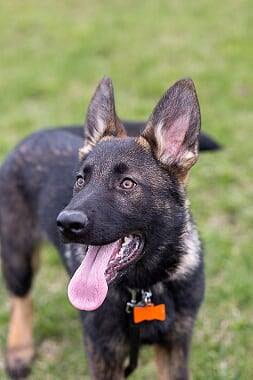So, you’re getting a new puppy…what an exciting time! Before you bring home your furry new family member, there are a few things to get ready for their arrival.
Key Considerations:
Puppy Proofing
Baby proofing is needed for all species! Get down on your hands and knees and explore your house from your puppy’s perspective. Look for hazards, considering anything that can fit in your puppy’s mouth.
Let’s start with inside the house! To keep your puppy safe consider covering up electrical sockets and eliminating exposed cords and wires so that they don’t use them as chews!
Did you know that there is a long list of toxic plants for puppies? Keep your plants out of the way to prevent puppies from getting into them. It’s also important to remove highly toxic plants from your home altogether, especially those where the pollen is the biggest culprit. Plants like lilies, aloe vera, and ivy are extremely toxic to your new puppy. If you are ever unsure about a plant, you can check out the ASPCA website.
On that note, check to make sure that medicinal products and potentially dangerous liquids/items are put away and out of reach. Don’t forget about any items that a puppy could easily snatch and swallow.
Secure their environment! Be sure to secure windows, and block access to stairs and balcony to keep your puppy safe. This brings us to outside the house: If you have access to a yard, ensure your puppy is securely contained. Secure areas where your puppy can crawl through and get out. Even outside, consider the types of plants to be sure they can’t get into anything that may harm them.

Your Shopping List: Puppy Edition
- Bedding
- Choose a bed that is easy to clean and is the correct size for your puppy as they continue to grow
- Puppies love to chew! A durable material is best, remove any damaged bedding and do not leave bedding unattended
- Crate
- It must provide enough room to stand up, turn around, lie down, and stretch out in their crate (suitable as the puppy grows)
- It must provide enough room to stand up, turn around, lie down, and stretch out in their crate (suitable as the puppy grows)
- Food and water bowls
- Stainless steel bowls have a longer life span than plastic and can be easily cleaned
- Plastic bowls may be chewed and are less ideal for puppies
- Consider the height and size of your puppy, larger breeds may need raised bowls
- Toys
- Ensure you have a variety of durable toys, that are good for chewing (especially for that teething phase!).
- Avoid toys that are intended for adult dogs
- Consider picking up a treat-dispensing toy to make feeding more fun and to keep up with a puppy’s energy!
- Inspect toys after each use, discarding any damaged or worn toys
- Grooming
- Purchase a brush, comb, or grooming mitt that is suitable for your puppy’s fur type
- Dog shampoo for bath days
- Nail clippers are a good idea to have on hand early and training your puppy at a young age can reduce stress for nail trims later in life
- Toothbrush and toothpaste from your veterinarian to start training for toothbrushing. Start after teething is complete
- Your veterinary healthcare team can help you with the selection and use of these products
- Puppy food
- Where possible, be sure to have at least a week of the puppy food your new puppy has been fed with prior to picking them up
7. Leash, collar, and ID tag
- Microchipping is the best means to identify your pet, remember to keep the information up to date
- Register your puppy for a license with your city or municipality
- ID tags are still beneficial to help your pet find its’ way home! Include their name, your address, phone number, and even an email-address
- Choose a leash and collar that will work well for your breed

Feeding Your Puppy
When you bring your new puppy home, they will have lots of things to adjust to. Sudden switches in their diet can cause digestive upsets, so it’s always best to start off with feeding the food their previous owner/breeder was feeding.
Choosing a New Food
Choosing a new food for your puppy can be overwhelming. Some things for you to consider:
- Before switching your puppy’s food, it is always recommended to discuss the transition with your veterinarian. This can also help to ensure you have chosen an appropriate food.
- Choose a food that is suitable for puppies. The AAFCO nutrition adequacy statement should state that the food is for all life stages or specifically for growth. This statement can be found on the pet food package or on the pet food company’s website. Your veterinarian can help you verify this statement and make sure it matches the front of the package.
- The puppy food should also be appropriate for your puppy’s adult size. Large or giant dog breeds have different nutritional needs compared to small or medium breeds. If you have a large or giant breed, the nutrition adequacy statement should specify, “…including the growth of large breed puppies.”. Be aware this may not match the front of the package!
- If you are unsure about a pet food company, ask your veterinarian for suggestions of brands that they trust.
Why is it so important to choose a food that is specifically formulated for puppies? Puppies have different nutrient requirements than their adult counterparts. This is to help facilitate the greater needs of your pup during the growth stage. Some nutrients of importance during growth can include (but is not limited to):
- Energy! Though technically not a nutrient in-of-itself, the energy needs of a puppy is much greater than that of an adult dog. Energy is needed to facilitate growth of bones, muscles, and tissues within the body! Too much of a good thing can be a very bad thing, obesity in puppies can predispose them to disease and injury, and throughout a dog’s life can reduce quality of life and shorten lifespan. Obesity prevention is better than cure. Moreover, in large and giant breeds, too high energy intake can result in rapid growth which may cause orthopedic or neurological problems later in life.
- Protein: Note that a puppy’s protein requirement is higher than adult dogs. Too low protein intake will be detrimental for the puppy’s growth. The amino acids that make up proteins are required for many anabolic processes within the body. By supplying highly digestible proteins, your puppy will be able to grow and maintain their muscle mass. Amino acids also help to support your pup’s immune system.
- Calcium and Phosphorus: Let’s not forget about the importance of these minerals during growth. The bones will grow as your puppy grows and providing calcium and phosphorus in the ideal amounts and ratios will help to keep their bones strong and healthy. Deficiencies in calcium or phosphorus, or both, can result in stunted growth and skeletal defects.
- Fats: Fats often get a bad reputation, but fats provide an excellent source of energy for your growing puppy. The essential fatty acids, such as docosahexaenoic acid (DHA) are also important for brain development, cognition, and trainability.
- Digestibility: Feeding a diet that is highly digestible will not just provide your puppy with the nutrients they need to thrive, but will also help with house and crate-training.
Transitioning Your Puppy to Their New Food
Now that you have your new puppy food, focus on a very slow transition. This will help minimize digestive upset for your puppy. Start with mixing their new food to their current food using the guide below.
If this all goes well, by day 7 you should be able to start feeding your puppy only their new food. If at any point your puppy experiences digestive upset (gas, diarrhea, bloating, etc) then they may need some more time to adjust at each step and a check in with their veterinarian may be warranted.
How Much and How Often to Feed
A great starting point for determining how much to feed your puppy is the feeding guide that is often provided on the back of the pet food bag or container or on the company’s website. Alternatively, your veterinarian can calculate how much to feed based on your puppies age, body weight, body condition score and predicted adult weight.
No matter which method is used to determine a food dose, adjustments may be needed. Weekly weigh-ins and body condition scoring can be used to help guide those adjustments. Veterinarians also use puppy growth charts to ensure healthy growth for your puppy.
WalthamTM Puppy Growth Charts can be used by veterinarians and pet owners to ensure your puppy is growing healthily. Use the link to find the right growth chart for your puppy based on their sex and breed size: Growth Charts
It is recommended to divide your puppy’s daily food allotment in multiple small meals. Let’s say 3 to 4 meals per day is a good starting point based on your puppy’s size and age. Smaller and younder puppies will need smaller, more frequent meals. Feeding small amounts multiple times a day helps your puppy digest their food and balance their energy and activity levels.
Multiple feedings also help to maintain appropriate blood sugar levels, which can be especially important for smaller breeds. For the larger breed puppies, multiple feedings can also prevent bloating and gas.
If you’re bringing home a more mature puppy (6 months or older) you can consider reducing the mealtime frequency to two meals per day.

Bringing Home Puppy
Keep your house calm and pleasant for the first few days since this is a new environment for the puppy. It can be overwhelming and frightening for them! We know you will want to show your puppy off to all your friends, but do try to avoid bringing any guests over until your puppy has settled into their new house. It’s important to also get your puppy used to a new routine such as specific mealtimes, walks, bedtime routine etc. This can help reduce stress for your puppy and is also great for their digestive system too!
Some initial training will be required during this time. The earlier you start training, the easier it will be! For training the basics consider puppy socialization and training classes when your puppy is fully vaccinated.
Now you’re all set for your new puppy to come home!
Written by:
Olivia Chiu BScH, MSc Student
Edited by:
Dr. Adronie Verbrugghe, DVM, PhD, European Veterinary Specialist in Veterinary and Comparative Nutrition® (Dip ECVCN)
Hannah Godfrey, MSc., PhD Student
Shoshana Verton-Shaw, RVT, VTS (Nutrition)
References
Burkholder WJ, Toll PW. Obesity. In: Hand MS, Thatcher CD, Remillard RL, Roudebush P, Morris ML, Novotny BJ. editors. Small animal clinical nutrition, 4th edition. Topeka, KS: Mark Morris Institute. 2000.
Case L.P. et al. Canine and Feline Nutrition: A resource for companion animal professionals 3rd ed. May 19, 2010.
National Research Council. (2006). Nutrient requirements of dogs and cats. Washington, DC. The National Academies Press.
Animal Poison Control [Internet]. ASPCA. [cited 2022Mar20]. Available from: https://www.aspca.org/pet-care/animal-poison-control


